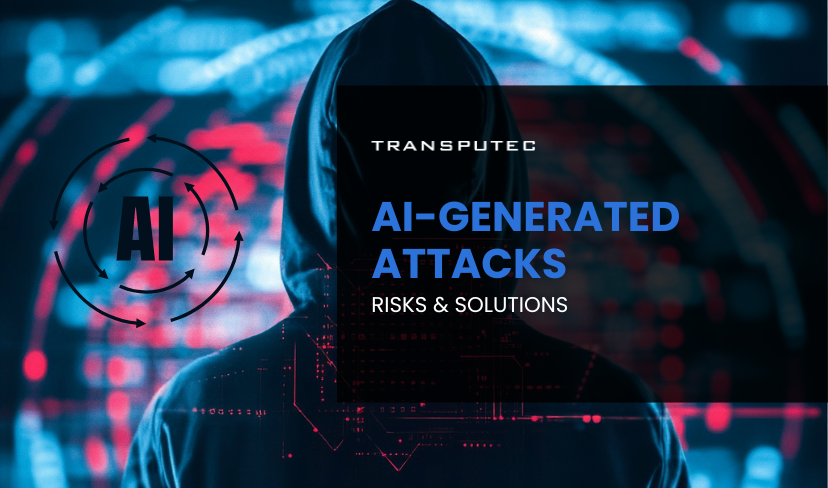Written by KRITIKA SINHA | MARKETING
Cybersecurity is at a crossroads. As artificial intelligence (AI) becomes a cornerstone of innovation, it is also being weaponised in unprecedented ways. AI-generated attacks represent the next generation of cyber threats—leveraging machine learning (ML) and automation to breach defences with speed and precision. According to Symantec, 90% of enterprises experience targeted attacks utilising AI-driven malware annually.
In this blog, we will unpack what AI-generated attacks are, how they work, their potential risks, and what steps businesses must take to stay protected.
What are AI-Generated Attacks?
AI-generated attacks refer to cyber threats designed and executed using artificial intelligence. Unlike traditional attacks, which rely heavily on human involvement, these attacks harness the power of AI algorithms to automate processes like reconnaissance, phishing, and malware creation.
At Transputec, we specialise in providing tailored cybersecurity solutions that empower you to stay one step ahead of attackers. Contact us today to speak with an expert and secure your business for the future.
Characteristics of AI-Generated Attacks
AI-generated attacks are redefining the cybersecurity landscape with their advanced capabilities and unique traits. Here are the key characteristics that set these attacks apart:
1. Automation
AI enables attackers to automate various stages of a cyberattack, from reconnaissance to execution. This reduces the time and effort required to launch an attack while allowing malicious actors to target multiple victims simultaneously.
- Example: Automated phishing tools can send personalised emails to thousands of recipients within minutes.
2. Personalisation
Leveraging machine learning and natural language processing (NLP), AI-generated attacks craft highly personalised messages or exploit strategies tailored to individual targets. This increases the likelihood of success by making attacks more convincing.
- Example: Phishing emails using AI may include details like the recipient’s job title, recent transactions, or preferences.
3. Adaptability
AI enables cyberattacks to adapt in real-time. If an initial attempt fails, AI can analyse the failure and modify its approach, increasing the likelihood of eventual success.
- Example: Malware can change its behaviour or code to bypass updated antivirus software.
4. Scalability
With AI, attackers can scale operations to unprecedented levels. This means targeting millions of users or systems simultaneously, making attacks more pervasive and difficult to contain.
- Example: AI-driven bots can scan thousands of networks for vulnerabilities at once, identifying targets faster than traditional methods.
5. Speed
AI-generated attacks operate at machine speed, executing actions and responding to defences in milliseconds. This minimises detection windows and maximises impact before mitigation measures can take effect.
- Example: AI-based ransomware can encrypt critical data across an entire network within seconds.
6. Exploitation of Human Vulnerabilities
AI-generated attacks often exploit psychological weaknesses in humans, such as trust or fear, by crafting emotionally resonant messages or scenarios.
- Example: Deepfake videos that impersonate executives to demand urgent financial transfers.
7. Cost-Effectiveness for Attackers
AI reduces the resources required to design and execute an attack. Once a system is trained, it can function independently, enabling attackers to launch complex campaigns with minimal investment.
- Example: Using an AI bot to create phishing templates instead of manually designing individual emails.
8. Difficulty in Attribution
The use of AI makes it harder to trace the origins of an attack. Attackers can obscure their methods and origins, complicating investigations and slowing down responses.
- Example: AI-designed malware that mimics legitimate processes, making forensic analysis challenging.
How AI-Generated Attacks Work
To understand the gravity of AI-generated attacks, it’s essential to dissect their methodologies. Below are four key types:
1. AI-Enhanced Phishing Attacks
AI sifts through data from social media, emails, and public records to generate hyper-personalised phishing messages. These emails mimic the tone, style, and content of legitimate communications, making them far more effective.
- Example: An AI-generated phishing email might address a recipient by name, reference a recent interaction, and include links to malicious websites.
2. Intelligent Malware Creation
Malware generated by AI is designed to adapt to its environment. Using algorithms, it can alter its behaviour or signature to avoid detection by traditional cybersecurity systems.
- Example: AI-driven ransomware identifies the most valuable assets on a network before encrypting them.
3. Deepfake Social Engineering
Attackers use AI to create realistic audio, video, or text messages to impersonate individuals.
- Example: A deepfake video of a CEO instructing the finance team to transfer funds to a fraudulent account.
4. Automated Reconnaissance and Exploitation
AI scans networks for vulnerabilities, such as outdated software or unsecured endpoints. Once identified, attackers exploit these vulnerabilities with minimal human intervention.
- Example: AI tools identify a zero-day vulnerability and deploy an exploit before a patch is available.
Protect your Business 24/7 with Transputec!
Our Managed SOC Cost Calculator estimates potential expenses for security tools and other costs based on your requirements.
The Risks of AI-Generated Attacks
AI-generated attacks are a growing menace in the digital age, leveraging the power of artificial intelligence to outpace traditional cyber defences. These attacks pose significant risks to individuals, businesses, and governments alike. Below, we explore the key risks associated with AI-generated attacks:
1. Increased Success Rates
AI allows attackers to craft highly targeted and personalised attacks, increasing the likelihood of success. By analysing vast amounts of data, AI-generated attacks can exploit specific vulnerabilities or manipulate human behaviour with precision.
- Example: AI-driven phishing emails that mimic the language and style of a trusted colleague or service.
2. Faster Attack Execution
AI operates at machine speed, enabling attackers to execute and adapt their methods far faster than humans can respond. This leaves minimal time for detecting and mitigating threats.
- Example: AI-driven ransomware encrypts critical systems across an organisation within seconds, crippling operations before a response is initiated.
3. Evasion of Detection
AI-generated attacks often use advanced evasion techniques, such as polymorphic malware, which continuously changes its code to avoid detection by traditional antivirus tools.
- Example: AI can create malware that imitates legitimate processes, fooling even sophisticated monitoring systems.
4. Mass Targeting Capabilities
AI enables attackers to scale their operations, targeting thousands or even millions of victims simultaneously. This amplifies the impact of attacks and makes them harder to contain.
- Example: AI-driven bots scan entire regions for vulnerable systems in minutes.
5. Economic Impact
The financial toll of AI-generated attacks is immense. Businesses face costs from data breaches, downtime, ransom payments, legal liabilities, and reputational damage.
- Data Point: The global cost of cybercrime, which includes AI-driven attacks, is projected to reach $10.5 trillion annually by 2025.
6. Escalating Costs for Cybersecurity
As AI-generated attacks become more sophisticated, organisations must invest heavily in advanced defences. This includes AI-powered detection tools, regular employee training, and robust incident response plans.
- Example: A mid-sized business spends thousands of dollars annually on penetration testing and monitoring solutions to keep pace with evolving threats.
How to Mitigate AI-Generated Attacks
Defending against AI-generated attacks requires a proactive and layered approach. Below are key strategies:
1. Leverage AI for Defense
Organisations must adopt AI-driven cybersecurity tools to counter AI-generated threats. These tools analyse patterns in real-time, identify anomalies, and neutralise attacks before they escalate.
- Example: Behavioural analytics can flag unusual login attempts, even if credentials are valid.
2. Enhance Employee Awareness
Employees are often the first line of defence. Regular training programs can help them recognise phishing attempts, deepfake content, and other AI-driven scams.
3. Implement Multi-Layered Security
A comprehensive approach includes endpoint protection, firewalls, multi-factor authentication (MFA), and encrypted communications to reduce vulnerabilities.
4. Conduct Regular Risk Assessments
Simulated attacks, penetration testing, and vulnerability scans can identify weaknesses before attackers exploit them.
5. Collaborate on Threat Intelligence
Sharing threat intelligence across industries and with cybersecurity providers helps organisations stay ahead of emerging tactics.
Why Transputec is Your Trusted Partner
As AI-generated attacks grow more sophisticated, businesses need a trusted partner to navigate this evolving landscape. At Transputec, we:
- Deploy Advanced AI Defences: From threat detection to incident response, our solutions use AI to safeguard your organisation.
- Provide Employee Training: Empower your team to recognise and respond to AI-driven threats.
- Offer Tailored Strategies: Every business is unique, and so are our cybersecurity solutions.
Conclusion
AI-generated attacks represent the cutting edge of cybercrime, posing significant challenges to businesses worldwide. By understanding the risks and implementing robust defences, you can protect your organisation from this evolving threat.
At Transputec, we’re here to help. Our experts specialise in crafting tailored solutions to address the most complex cybersecurity challenges.
Contact us today to secure your business against AI-generated attacks and build a resilient future.

Secure Your Business!
Ready to explore how we can enhance your security posture? Contact us today to speak with one of our experts.
FAQs
How do AI-generated attacks differ from traditional cyberattacks?
AI-generated attacks automate tasks like phishing, malware creation, and reconnaissance, making them faster, more scalable, and harder to detect.
Can AI-generated attacks be completely prevented?
While no system is entirely foolproof, robust defences such as AI-driven security tools, employee training, and multi-layered protection significantly reduce the risks.
Which sectors are most vulnerable to AI-generated attacks?
Industries handling sensitive data, such as healthcare, finance, and government, are frequent targets. However, all sectors with digital operations are at risk.
Are small businesses at risk from AI-generated attacks?
Yes, attackers often target small businesses due to their limited cybersecurity resources. AI enables them to attack multiple small targets efficiently.
How does Transputec address AI-generated threats?
Transputec offers AI-powered solutions, employee training, and strategic guidance to help businesses detect, prevent, and respond to AI-driven threats effectively.






